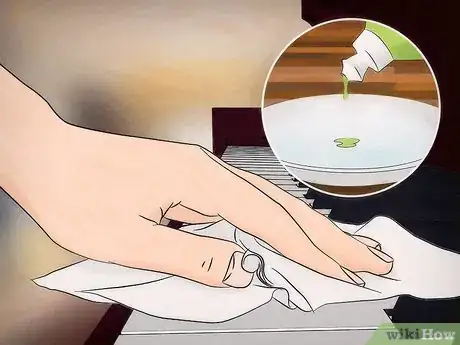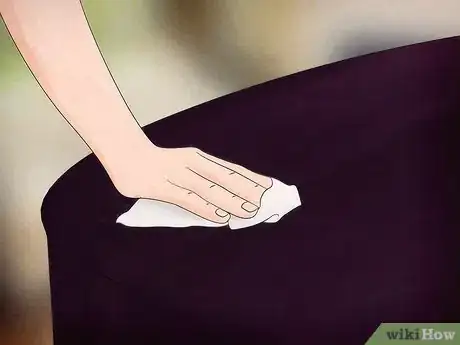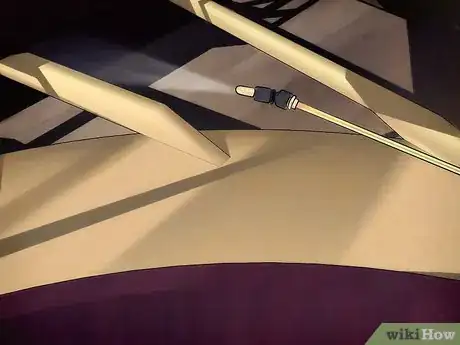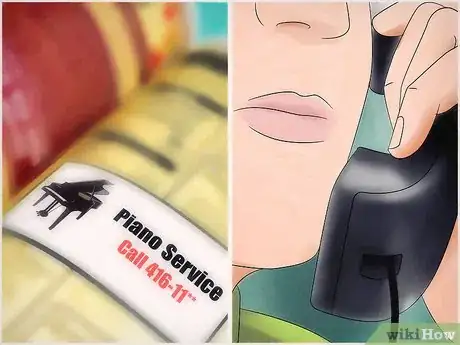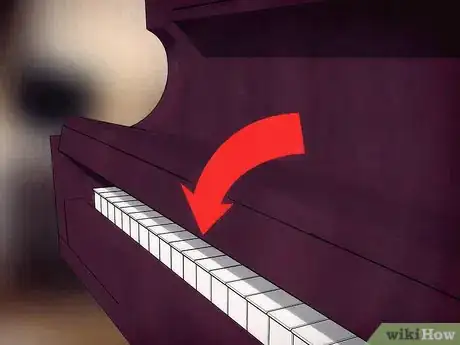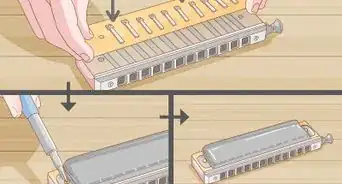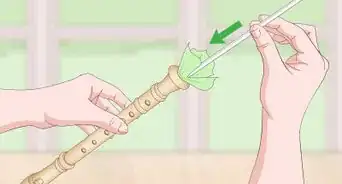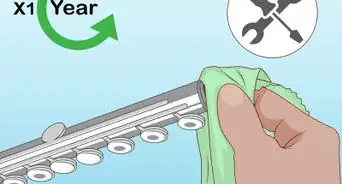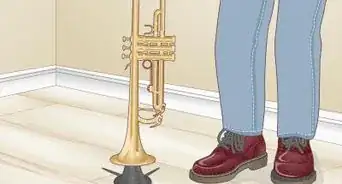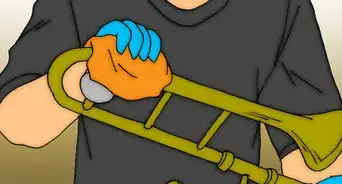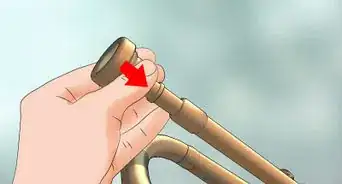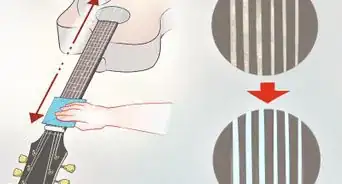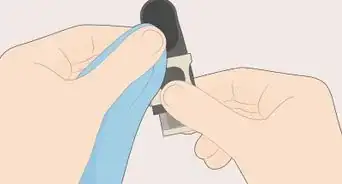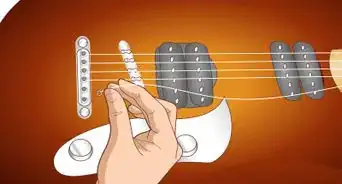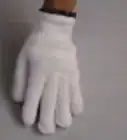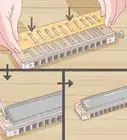This article was co-authored by Michael Noble, PhD. Michael Noble is a professional concert pianist who received his PhD in Piano Performance from the Yale School of Music. He is a previous contemporary music fellow of the Belgian American Educational Foundation and has performed at Carnegie Hall and at other venues across the United States, Europe, and Asia.
wikiHow marks an article as reader-approved once it receives enough positive feedback. In this case, 87% of readers who voted found the article helpful, earning it our reader-approved status.
This article has been viewed 139,336 times.
Having your own piano is a great privilege, but proper care must be taken to keep the instrument clean and free of damage. With regular maintenance and dusting, your piano shouldn't require professional cleaning too often. However, it's important to use the right products and techniques when you're cleaning in order to avoid damaging or scratching the piano.
Steps
Cleaning the Keys
-
1Dust the keys. Use a feather duster and apply light pressure to remove dust from the keys. Even dust can scratch the piano, so be very gentle. Be sure to get into all the nooks and crannies as well, such as between the keys.[1]
- Dust the piano every couple days to prevent dust from settling on the piano and making its way into the soundboard and the action mechanism.
-
2Clean ivory keys. Find a clean white cloth made of a soft and lint-free material like flannel or microfiber. Wet the cloth with clean water, and then wring out as much of the water as possible. Clean a few keys at a time by gently rubbing them with the damp cloth in a back-to-front direction. Immediately go over those keys with a dry cloth to remove any excess water before cleaning more keys.
- Avoid coarse cloths, synthetic materials, and paper towels, all of which can scratch the keys. Don't use colored materials, because they can transfer dye to the piano.
- Don't use a side-to-side motion when cleaning, because this can push dirt and moisture down between the keys.
- To identify ivory keys, look for a grain that runs in the direction of the keys, fine splits, warped areas, and a matte finish.
Advertisement -
3Clean plastic keys. Because plastic keys are synthetic and not porous like ivory, you can clean them with extra cleaning products if necessary. Plastic keys will always be perfectly flat and smooth, and they won't have a grain or warp marks like ivory ones. To clean plastic keys, you'll need a cloth damp with water and cleaning solution, a cloth damp with just water, and a dry cloth.
- Fill a small bowl with clean water and a few drops of liquid dish detergent or vinegar.[2] Mix the solution, then dip in a clean white flannel or microfiber cloth.
- Wring out the excess water and gently rub a few keys using the back-to-front motion.
- Take the cloth that's damp with clean water and go over those keys to remove excess cleaning solution.
- Go over the keys with the dry cloth. Repeat with a few more keys until all the keys are clean and dry.
Cleaning the Casework and Soundboard
-
1Clean the finish. Gently rub the outside of the piano with a clean damp cloth, working in small sections, and then drying those small sections with a dry cloth. Use straight strokes in the direction of the wood grain, rather than circular motions. This will prevent swirl marks and streaks.
- Be sure to use a non-abrasive cloth, such as cotton or microfiber. This process will remove dust from the casework and remove dirt, smudges, and fingerprints.
- Make sure the cloth is just slightly damp. You don't actually want the damp cloth to leave behind any visible moisture.
-
2Polish the finish only when necessary. When polishing is necessary, apply a small amount of piano polish directly to a soft, lint-free cloth.[3] Gently rub a small section of the piano in the direction of the grain. Be particularly delicate with corners and edges, where there's only a thin layer of finish. Then, wipe away any excess polish using a clean cloth.
- It's important that you use specific polish that's safe for pianos, and only polish when the piano really needs a thorough cleaning, buffing, or has some fine scratches that need to be filled. Polishing can actually damage the finish on the piano, and if it gets inside, it can damage the action components.
- Don't use a high-gloss polish if your piano has a lacquer finish, because lacquer finishes aren't meant to be high-gloss. Instead, use a product with a satin finish. Only use high-gloss polishes on polymer finishes.
- Do not use regular household furniture polish, avoid silicone-based products, avoid products with lemon oil, and don't spray aerosol products on or near the piano, because they can damage the exterior and interior of the piano.
-
3Blow dust from the soundboard. Whether you have a grand piano or an upright, you can clean out the soundboard by blowing away accumulated dust and dirt. To do this, either use a vacuum on reverse or a can of compressed air. However, it's important that you only do this if you're experienced with cleaning piano interiors, because it's very easy to damage the strings and dampers. If you have doubts, call a professional to clean inside your piano. To clean inside yourself:
- Hold the vacuum or compressed air nozzle a few inches (several centimeters) from the surface of the soundboard and use vertical strokes in the direction of the strings to blow out dust.[4]
- Make sure that you don't touch the strings or the dampers with the vacuum nozzle, the air can, or your fingers.
- Blow the dust and dirt to an accessible corner of the piano, and then use a vacuum on suck mode to clean up the mess.
-
4Call a professional cleaner as an alternative. A professional has the tools, experience, and knowledge necessary to clean the action parts of your piano without damaging the delicate and sensitive components.
- Professional cleaners won't just clean what they can see, and they'll also remove the keys and other parts to get at dust and dirt in every nook and cranny.[5]
Keeping the Piano Clean
-
1Wash your hands before you play. Dirty and oily hands and fingers are the major culprit that will make your piano dirty, so always wash and dry your hands well before you play.[6]
- To wash your hands properly, wet them under running water and add soap. Lather your hands for at least 20 seconds, getting the fronts, backs, between the fingers, and under the nails. Rinse with running water, then pat dry with a clean towel.[7]
-
2Protect the piano from the elements. Sun, humidity, and extreme hot and cold can age, fade, and damage your piano. Keep the piano out of direct sunlight, and store it in a temperature and humidity controlled room.
- Don't keep the piano near any drafts or vents, and don't store it in any room that's prone to dampness.
-
3Don't place objects directly on the piano without protection. If you do have any objects on your piano, such as a lamp or metronome, make sure they have protective felt on the base that won't scratch the surface.
- Never place drinks, food, or liquids on top of the piano, and never let the piano come in contact with vinyl or rubber.
-
4Close the lid when not in use. Whenever the piano isn't being used, make sure the lid is covering the keys. This will protect them from the sun, dust, dirt, and spills.[8]
Expert Q&A
-
QuestionHow do you clean dirty piano keys?
 Michael Noble, PhDMichael Noble is a professional concert pianist who received his PhD in Piano Performance from the Yale School of Music. He is a previous contemporary music fellow of the Belgian American Educational Foundation and has performed at Carnegie Hall and at other venues across the United States, Europe, and Asia.
Michael Noble, PhDMichael Noble is a professional concert pianist who received his PhD in Piano Performance from the Yale School of Music. He is a previous contemporary music fellow of the Belgian American Educational Foundation and has performed at Carnegie Hall and at other venues across the United States, Europe, and Asia.
Professional Pianist You can clean your piano keys with a wet wipe, like some sort of a sanitary wipe. You only need tot make sure that you don't squeeze the liquid into the keys too much. Just wipe the surface gently to get the grime off. It's good to clean the keys, because they can be really dirty.
You can clean your piano keys with a wet wipe, like some sort of a sanitary wipe. You only need tot make sure that you don't squeeze the liquid into the keys too much. Just wipe the surface gently to get the grime off. It's good to clean the keys, because they can be really dirty. -
QuestionWhere can I order satin polish for my mahogany piano?
 Community AnswerYou can look for it at a hardware store or use online shopping.
Community AnswerYou can look for it at a hardware store or use online shopping. -
QuestionHow do I find piano tuners and cleaners in my area?
 Community AnswerGo to Google Maps and type "piano tuners" into the search function and you should receive a list of service providers nearby.
Community AnswerGo to Google Maps and type "piano tuners" into the search function and you should receive a list of service providers nearby.
Warnings
- Never spray any cleaning products directly onto the piano keys, because it can bet between the keys and damage the strings below.⧼thumbs_response⧽
References
- ↑ http://takelessons.com/blog/how-to-clean-a-piano
- ↑ http://www.childrensmusicworkshop.com/resources/articles/pianokeys/
- ↑ http://www.childrensmusicworkshop.com/resources/articles/pianokeys/
- ↑ https://www.youtube.com/watch?v=UL4FzkXtVSk
- ↑ https://www.youtube.com/watch?v=UL4FzkXtVSk
- ↑ http://takelessons.com/blog/how-to-clean-a-piano
- ↑ http://www.cdc.gov/handwashing/when-how-handwashing.html
- ↑ http://takelessons.com/blog/how-to-clean-a-piano
About This Article
To clean a piano, start by dusting the keys every few days with a feather duster. For a deeper clean, use a wet cloth with clean water on ivory keys or water and dish soap on plastic keys, making sure to dry the keys as you go. Next, gently rub a clean damp cloth along the outside of the piano, working in small sections, then drying the area with a soft cloth. If you need to clean the soundboard, hold a vacuum set on reverse or a compressed air nozzle a few inches away from the surface, and use vertical strokes in the direction of the strings to blow out the dust. To learn how to keep your piano clean, keep reading!


